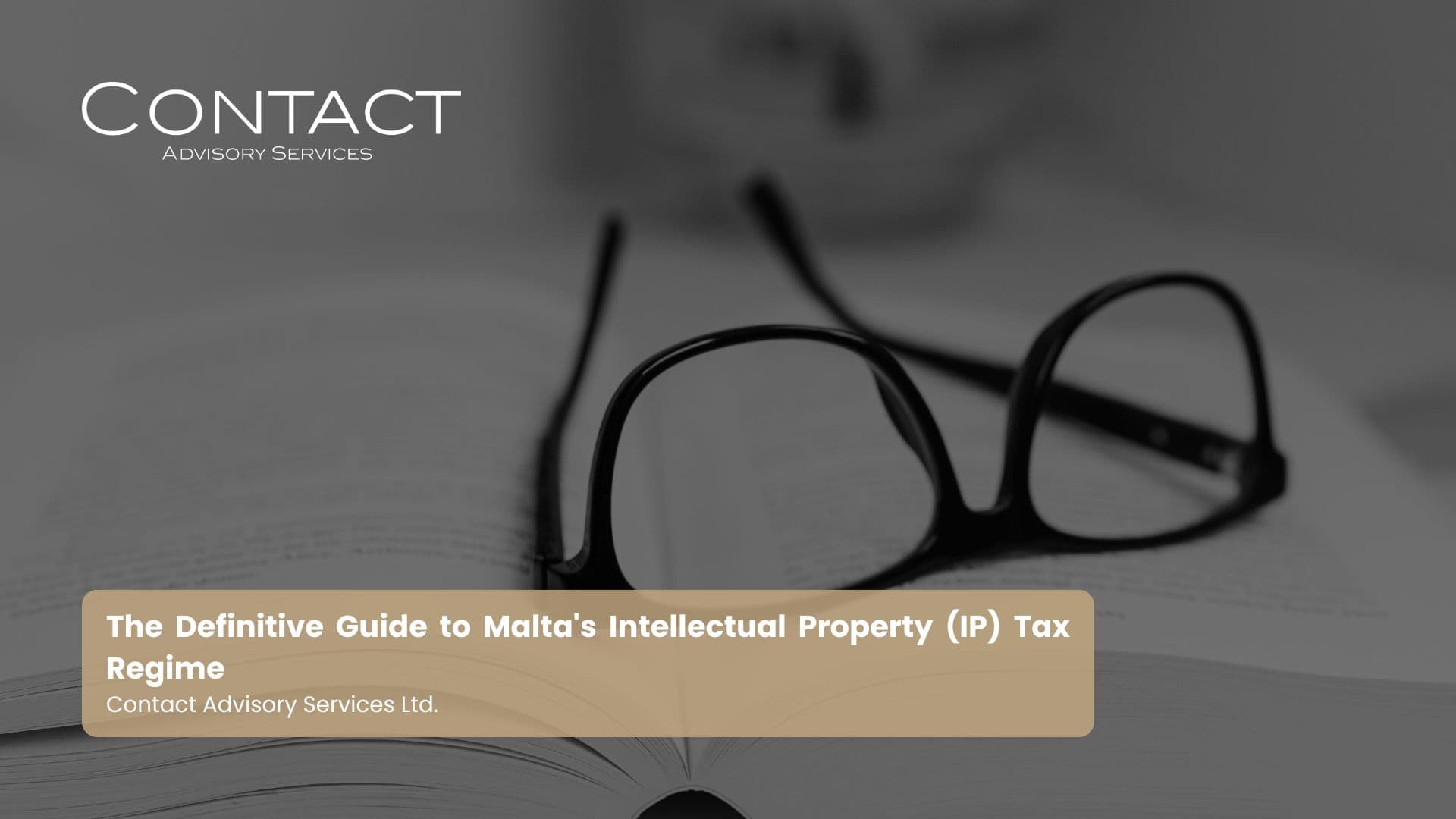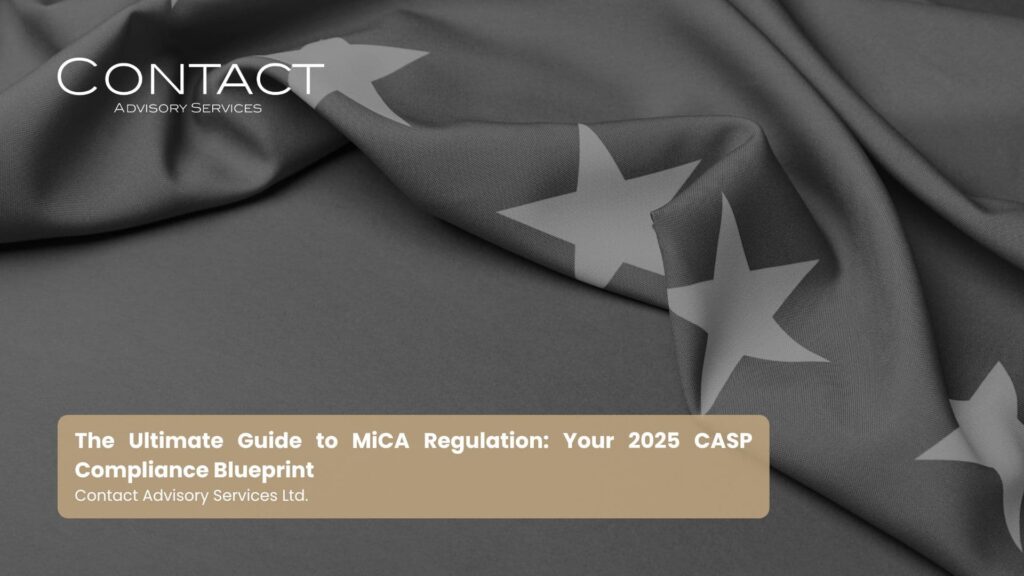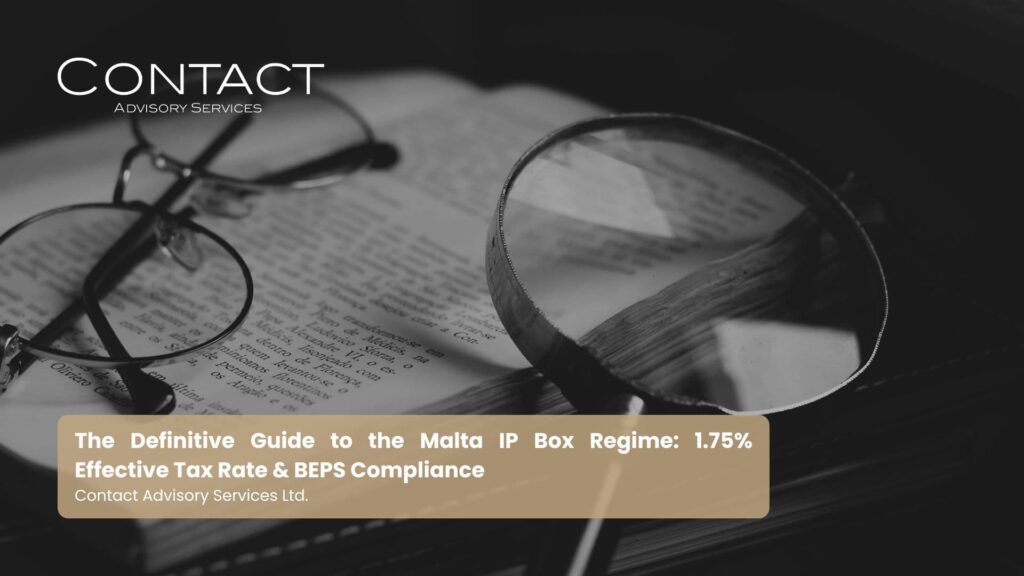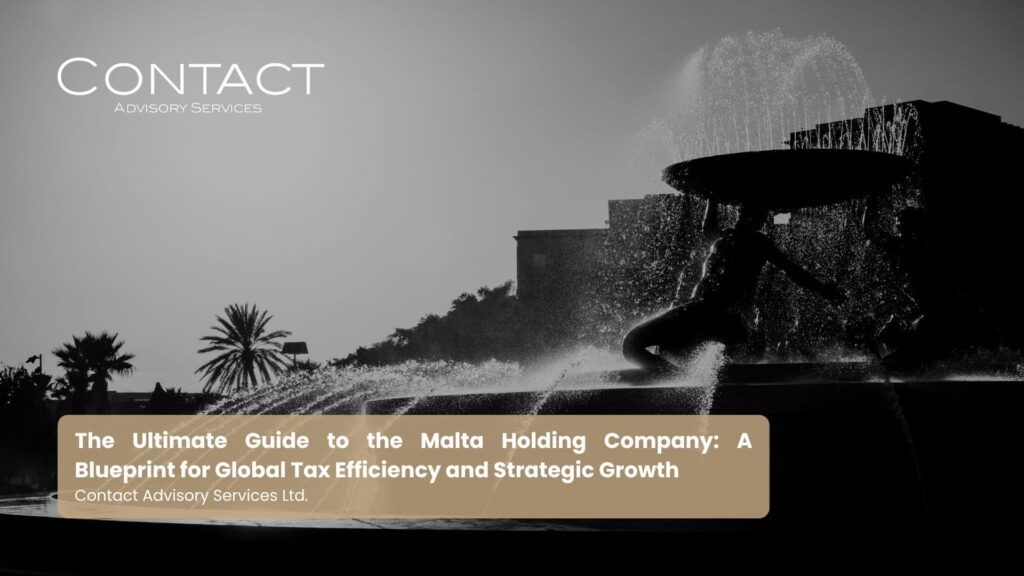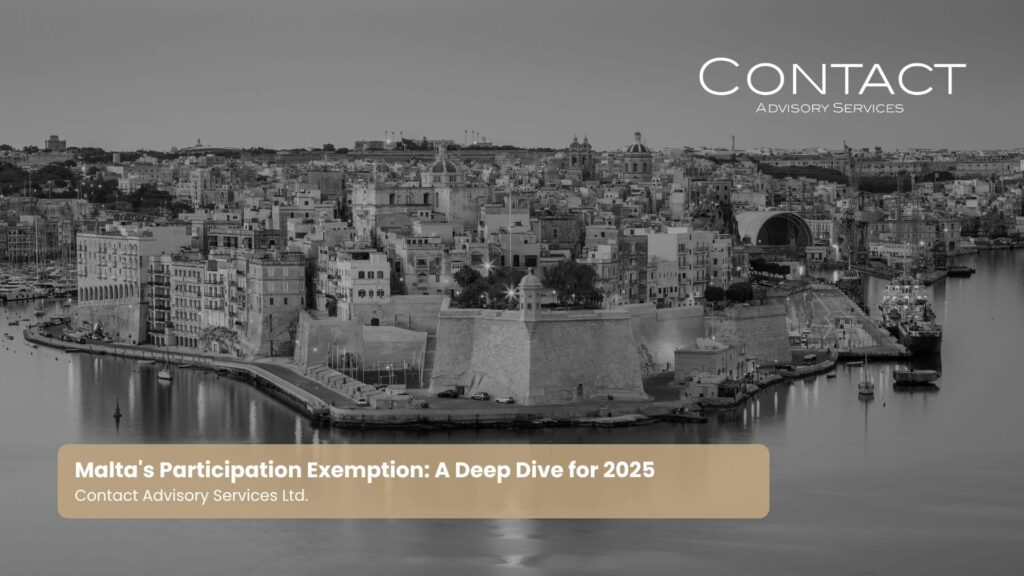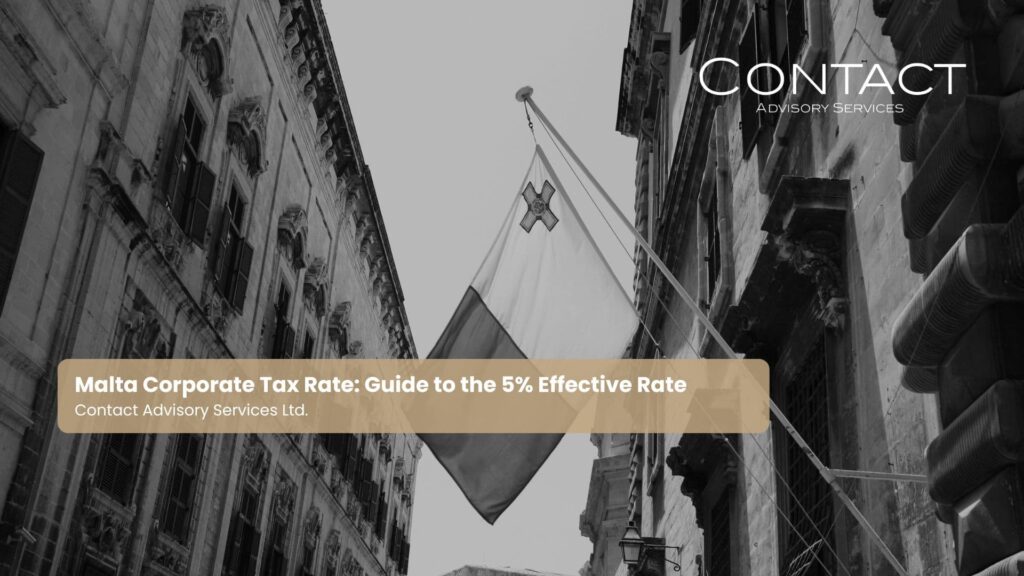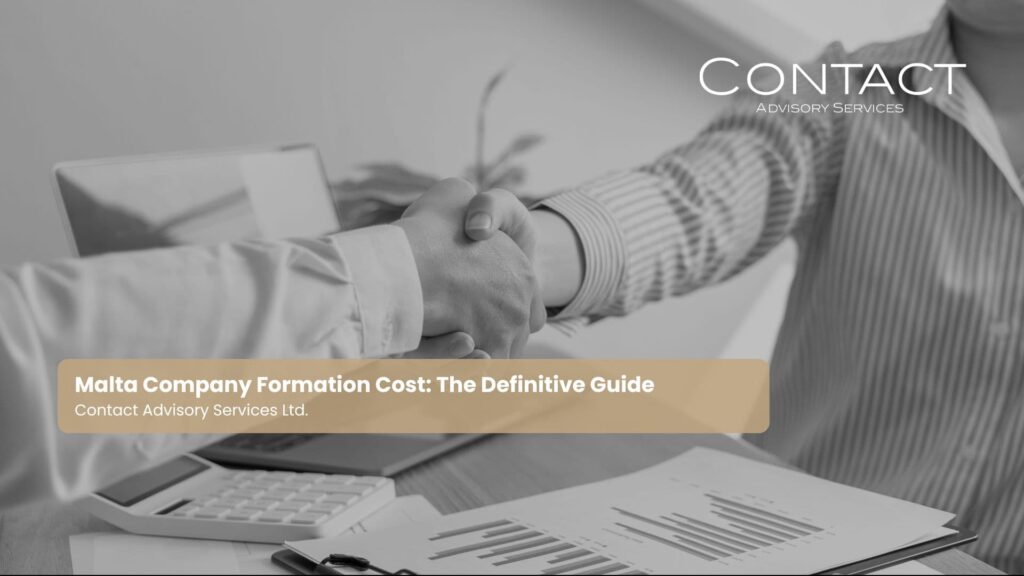- What is the Malta Intellectual Property Tax Regime?
- What are Malta's R&D Tax Incentives for 2025?
- What is the Malta Patent Box Regime and its Deduction Rules?
- How does the Malta IP Box Nexus Approach work?
- What is 'Malta Patent Box Qualifying IP'?
- What is the process for the Malta Enterprise IP Certification?
- What is the 'Malta Intellectual Property Deduction' for Amortization?
- How does Malta's IP regime compare to other EU hubs?
- How do you Set Up an IP Holding Company in Malta?
- What if My IP Doesn't Qualify for the Patent Box?
- Frequently Asked Questions (FAQ)
- Conclusion: Your Premier EU Hub for Innovation
- Take the Next Step
In the 21st-century economy, value is intangible. A company’s future success is often written not in its ledgers of physical assets, but in its portfolio of patents, its proprietary software code, and its protected copyrights. For innovative companies, protecting and commercializing this intellectual property is the primary business objective. However, finding a jurisdiction that rewards this innovation with a competitive, stable, and compliant tax framework is one of the most significant strategic challenges.
This is where the Malta intellectual property tax regime emerges as a premier, EU-approved solution. It is a comprehensive ecosystem designed not just to hold IP, but to create and nurture it. The regime’s flagship incentive, the Malta Patent Box, offers a headline-grabbing effective corporate tax rate on IP profits as low as 1.75% . But this is only part of the story. This benefit is powerfully combined with generous Malta R&D tax incentives , flexible intellectual property amortization rules, and a 0% withholding tax environment.
However, navigating this regime requires expert guidance. How does the 1.75% rate actually work? Is it compliant with the OECD’s strict “Nexus Approach”? What exactly qualifies as “software copyright” for tax purposes? And how does the Malta IP box vs Ireland KDB or the Netherlands Innovation Box truly stack up?
As Contact Advisory Services Ltd., an MFSA (Malta Financial Services Authority) Authorized Company Services Provider, we specialize in structuring these solutions. This definitive guide is built from our direct, practical experience. We will dissect every component, providing factual, actionable answers to every question you have, ensuring you can build a robust, compliant, and exceptionally efficient IP structure in Malta.
What is the Malta Intellectual Property Tax Regime?
The Malta intellectual property (IP) tax regime is a multi-layered legal framework designed to attract high-value innovation. It consists of three main pillars: (1) The Patent Box Regime (Deduction) Rules, which can lower the effective tax on IP profits to 1.75%, (2) Generous R&D tax incentives to fund development, and (3) Flexible capital allowance (amortization) rules for IP acquisition.
What are the primary Malta tax benefits for IP?
The main benefits include an effective corporate tax rate as low as 1.75% on qualifying IP income, R&D tax credits of up to 45%, accelerated amortization on IP costs over 3 years, and 0% withholding tax on outbound royalty payments. These incentives are designed to work together.
The Maltese framework offers a complete “cradle-to-commercialization” solution for a company’s intangible assets. Here’s how the key benefits stack up:
- The Patent Box Regime (1.75% ETR): This is the flagship incentive. Instead of offering a low statutory rate, it provides a 95% deduction on qualifying income, resulting in the highly competitive Malta IP tax 1.75% effective rate.
- Generous R&D Tax Incentives: Through Malta Enterprise, the state’s development agency, companies can receive cash grants and tax credits of up to 45% on their R&D expenditure. This significantly lowers the cost of creating the IP in the first place.
- Malta Intellectual Property Amortization: The regime allows a company to claim capital allowances (deductions) on the cost of acquiring or developing IP. The Malta accelerated IP deduction 2024 rules allow this cost to be written off over as few as three years.
- 0% Withholding Tax: Malta does not levy any withholding tax on outbound royalties, dividends, or interest payments to non-residents, making it exceptionally efficient for repatriating profits.
- EU & OECD Compliance: The entire regime is fully compliant with the OECD’s Base Erosion and Profit Shifting (BEPS) Action 5, specifically the Malta IP box nexus approach . This ensures long-term stability and reputational integrity.
How do these components create a holistic IP strategy?
These components create a virtuous cycle. A company can use Malta Enterprise R&D grants to fund its development, significantly reducing its costs. The expenditure on that R&D then builds the “Nexus Ratio,” which in turn unlocks the 1.75% tax rate on the profits generated.
This holistic ecosystem is Malta’s key differentiator. A company can:
- Fund: Apply for Malta R&D tax incentives 2024 to get tax credits on developer salaries and research costs.
- Develop: Perform the R&D in Malta, building up “Qualifying Expenditure” for the Nexus Approach.
- Certify: Obtain Malta Enterprise IP certification for the new patent or software copyright.
- Profit: License the IP and apply the Patent Box regime deduction rules to achieve the 1.75% ETR.
- Repatriate: Pay dividends or royalties from the Maltese company to a parent or shareholder with 0% withholding tax.
If, for any reason, the IP doesn’t qualify (e.g., it’s a trademark or fails the Nexus test), the Malta company tax refund system acts as a “safety net,” providing a 5% effective corporate tax rate on active trading income.
What are Malta’s R&D Tax Incentives for 2025?
The Malta R&D tax incentives for 2025 are a suite of generous support schemes offered by Malta Enterprise to encourage research and development. The primary incentive is the “R&D 2023 – 2027” scheme, which provides tax credits of up to 45% on qualifying R&D costs, such as researcher salaries and equipment.
How do these R&D tax credits work?
These incentives provide a direct, cash-flow-positive benefit to companies performing R&D in Malta. The tax credit is calculated as a percentage of eligible costs and can be used to offset tax payable by the company. If the credit is larger than the tax due, it can be carried forward or, in some cases, refunded as a cash grant.
The goal is to make Malta a cost-effective location to perform the R&D, not just to book the profits. The tax credit rates are tiered based on the size of the company:
- Small Enterprises: 45% tax credit on eligible costs
- Medium Enterprises: 35% tax credit on eligible costs
- Large Enterprises: 25% tax credit on eligible costs
Eligible costs include: - Wages and salaries of researchers, technicians, and other R&D staff.
- Costs of instruments and equipment used for the R&D project.
- Costs of contractual research, technical knowledge, and patents bought or licensed.
- A portion of overheads and other operating expenses directly related to the R&D.
How do these R&D incentives interact with the Patent Box?
This is the most powerful part of the Maltese system: the incentives are complementary. A company can “double-dip” by using the same expenditure to claim an R&D tax credit and to build its Nexus Ratio for the Patent Box.
Here is a practical example of this “double benefit”:
Year 1: Development
A small Maltese tech company, “FinTech Ltd,” spends €100,000 on developer salaries to create a new piece of software.
- This €100,000 is “Qualifying Expenditure” (QE) for the Patent Box.
- FinTech Ltd applies to Malta Enterprise and receives a 45% R&D tax credit , which is €45,000 . This credit directly reduces its tax bill.
Year 2: Commercialization
- The software is certified as “Qualifying IP” and generates €200,000 in licensing income.
- When calculating the Patent Box benefit, the company’s Nexus Ratio is QE / TE.
- The full €100,000 (which was already subsidized by the 45% credit) is used as QE, giving a perfect 1.0 Nexus Ratio.
- The company can now apply the 95% deduction, resulting in a 1.75% effective tax rate on its €200,000 profit.
The company’s R&D cost was reduced by 45%, and that same expenditure unlocked the 1.75% tax rate. This synergy is a core pillar of the Malta intellectual property tax regime .
What is the Malta Patent Box Regime and its Deduction Rules?
The Malta Patent Box (officially, the “Patent Box Regime (Deduction) Rules, 2019”) is the primary tax incentive. It allows a company to claim a deduction of up to 95% of the net income derived from “Qualifying IP.” This deduction, not a special tax rate, is the mechanism that achieves the 1.75% ETR.
What exactly are the ‘Patent Box Regime Deduction Rules Malta’?
The rules, found in Legal Notice 208 of 2019, outline the entire framework. They define what constitutes Qualifying IP, mandate the use of the OECD’s “Modified Nexus Approach,” and provide the formula for calculating the 95% deduction.
The patent box regime deduction rules Malta are the legal foundation of the system. Their key provisions are:
- The 95% Deduction: A company can claim a deduction equal to 95% of its “Qualifying IP Income.”
- The Nexus Ratio: This deduction is “gated” by the Nexus Ratio. The full 95% deduction can only be claimed on the portion of income that is supported by substantive R&D expenditure (as calculated by the Nexus Ratio).
- Qualifying IP: The rules provide a specific, and in Malta’s case, favorable list of what IP is eligible (e.g., patents, software).
- Certification: The rules mandate that the IP must be certified by Malta Enterprise.
How is the ‘Malta IP tax 1.75%’ rate actually calculated?
The Malta IP tax 1.75% is the effective tax rate, not a statutory one. It is the simple mathematical result of applying Malta’s 35% headline corporate tax rate to the 5% of IP income that remains after the 95% deduction is taken.
This is a critical distinction. Malta’s corporate tax rate is 35%. The Patent Box just removes 95% of the IP-related income from this calculation.
Here is the precise calculation:
- Step 1: A company earns €1,000,000 in royalties from a qualifying, certified patent.
- Step 2: The company has a full 1.0 Nexus Ratio (meaning all R&D was done in-house).
- Step 3: The company claims the 95% deduction allowed by the Patent Box Rules: €1,000,000 * 95% = €950,000.
- Step 4: This deduction reduces the company’s taxable income: €1,000,000 (Income) – €950,000 (Deduction) = €50,000 (Taxable Income).
- Step 5: The company applies Malta’s 35% corporate tax rate to this remaining taxable income: €50,000 * 35% = €17,500.
- Step 6: The effective tax rate on the total €1,000,000 profit is €17,500 / €1,000,000 = 1.75%.
This effective corporate tax rate Malta IP of 1.75% is the best-case scenario, achievable only with a full Nexus Ratio.
How does the Malta IP Box Nexus Approach work?
The Malta IP Box Nexus Approach is the formula that makes the regime OECD-compliant. It ensures that the tax benefit (the 95% deduction) is directly and proportionally linked to the amount of substantive R&D expenditure the company incurred to develop that IP.
What is the ‘Modified Nexus Approach’ in simple terms?
It is a “no substance, no benefit” rule. A company can no longer buy a patent, move it to a low-tax country, and enjoy tax breaks. The Nexus Approach requires a company to prove it created the value (through R&D) in order to get the tax benefit on the income from that value.
This approach, mandated by BEPS Action 5, is what gives the Maltese regime its long-term stability and credibility. It is a formula that “gates” the income eligible for the deduction.
The Formula:
Eligible Income for Deduction = Total IP Income * (Qualifying Expenditure / Total Expenditure)
This fraction (Qualifying Expenditure / Total Expenditure) is the “Nexus Ratio.”
Are passive IP holding companies eligible?
No, they are not. The Malta IP Box Regime is specifically designed to exclude passive holding structures . If a company’s sole activity is to hold IP assets and receive passive royalties without contributing to the development, management, or maintenance of that IP, it will not qualify for the benefits.
The regime targets active R&D and commercialization. A company must demonstrate:
- Active management: Strategic decisions regarding the IP are made in Malta.
- Substance: The company has the necessary physical presence, employees, and resources in Malta to perform the “Development, Enhancement, Maintenance, Protection, and Exploitation” (DEMPE) functions related to its IP.
- Incurred expenditure: The company has directly funded the R&D that created the IP.
This focus on substance is non-negotiable and is a cornerstone of the regime’s legitimacy.
What is ‘Qualifying Expenditure’ (QE) in the Nexus Ratio?
“Qualifying Expenditure” (QE) is the “good” expenditure that forms the numerator of the ratio. It includes all in-house R&D costs (like salaries) and R&D outsourced to unrelated third parties, plus a 30% “uplift.”
QE includes:
- R&D costs incurred directly by the Maltese company.
- Salaries, materials, and overheads directly attributable to the R&D.
- R&D activities outsourced to an unrelated entity (in Malta or abroad).
- The 30% Uplift: The rules also allow a company to increase its QE by a 30% “uplift.” This uplift is capped at the total amount of “non-qualifying” expenditure (acquisition costs + related-party outsourcing). This is a buffer to ensure companies that have some acquisition costs are not unfairly penalized.
What is ‘Total Expenditure’ (TE) in the Nexus Ratio?
“Total Expenditure” (TE) is the denominator of the ratio. It includes all QE plus any costs that do not represent genuine, in-house innovation, such as the cost of acquiring the IP or outsourcing R&D to a related company.
TE includes:
- All Qualifying Expenditure (QE)
- PLUS: The cost of acquiring the intellectual property.
- PLUS: The cost of R&D outsourced to a related party (e.g., a parent or subsidiary).
Can you provide a worked example of the Nexus calculation?
Yes. A worked example clearly demonstrates how these components interact to determine the final tax bill. Let’s assume a Maltese tech company, “TechServe Ltd.,” develops a new software platform.
Assumptions:
- Qualifying IP Income (from software licenses): €1,000,000
- Direct R&D Costs (local developer salaries): €150,000
- Unrelated Subcontracting (hired a specialist UK firm): €50,000
- Related-Party Subcontracting (used a sister company for QA): €30,000
- IP Acquisition Costs (bought a small code library): €20,000
Step 1: Calculate QIPE (Good Costs)
- QIPE = (Direct R&D + Unrelated Subcontracting) + 30% Uplift
- QIPE = (€150,000 + €50,000) = €200,000
- Uplift Calculation: 30% of €200,000 = €60,000.
- Uplift Cap: Total “bad costs” = €30,000 + €20,000 = €50,000.
- Applied Uplift: The uplift is capped at the lower of the 30% (€60k) or the total bad costs (€50k). So, we can add €50,000.
- Final QIPE = €200,000 + €50,000 = €250,000
Step 2: Calculate TIPE (Total Costs)
- TIPE = (Direct R&D + Unrelated Subcontracting) + (Related Subcontracting + Acquisition)
- TIPE = (€150,000 + €50,000) + (€30,000 + €20,000)
- Final TIPE = €250,000
Step 3: Calculate the Nexus Ratio
- Nexus Ratio = QIPE / TIPE
- Nexus Ratio = €250,000 / €250,000 = 100% (or 1)
- Result: Because the company’s “good” costs, amplified by the uplift, equalled its total costs, it is entitled to the full benefit.
Step 4: Calculate the Final Tax
- Eligible Income = Total IP Income * Nexus Ratio = €1,000,000 * 100% = €1,000,000
- Deduction = Eligible Income * 95% = €1,000,000 * 95% = €950,000
- Taxable Income = Total IP Income – Deduction = €1,000,000 – €950,000 = €50,000
- Final Tax Payable = Taxable Income * 35% = €50,000 * 35% = €17,500
Effective Tax Rate = €17,500 / €1,000,000 = 1.75%
What is ‘Malta Patent Box Qualifying IP’?
Malta Patent Box qualifying IP is a specific list of intangible assets that are eligible for the 95% deduction. The most significant items on this list are patents (and patent applications) and, crucially for the modern economy, copyrighted software .
How is ‘Malta software copyright tax’ treated?
This is a key advantage of the Maltese regime. The Malta software copyright tax treatment is exceptionally favorable, as “software protected by copyright” is explicitly included as “Qualifying IP.” This makes Malta a premier hub for tech, SaaS, and FinTech companies.
Unlike some jurisdictions that are more ambiguous or exclude software, Malta’s rules are clear. This means income from the following can qualify for the 1.75% ETR:
- Software licensing fees
- Software-as-a-Service (SaaS) subscription income
- Income from product sales where the value is primarily derived from the embedded copyrighted code.
To qualify, the software must be the result of a substantive R&D project (which builds the Nexus Ratio) and cannot be “marketing” software.
What is the full list of eligible and non-eligible IP?
The rules are very specific about what is in and what is out. The regime is designed to reward technical and scientific innovation, not marketing and branding.
Table: Qualifying vs. Non-Qualifying IP
| Qualifying IP (Eligible for 1.75% ETR) | Non-Qualifying IP (Not Eligible) |
| Patents (granted or applied for) | Trademarks & Service Marks |
| Copyrighted Software | Brand Names & Trade Names |
| Utility Models | “Marketing Intangibles & “”Know-how””” |
| Orphan Drug Designations | Customer Lists & Databases |
| Plant Variety Rights | Trade Secrets (unless part of a patent) |
| Plant Protection Products | Goodwill |
What is the process for the Malta Enterprise IP Certification?
The Malta Enterprise IP certification is a mandatory prerequisite for claiming the Patent Box deduction. It is a formal process where a company must apply to Malta Enterprise, the state’s economic development agency, to have its IP and its R&D expenditure formally recognized as “qualifying.”
Why is this certification step so important?
This certification provides legal certainty for both the taxpayer and the tax authorities. It is the official “gateway” to the regime. A company cannot simply claim the 95% deduction on its tax return without first having its IP and R&D expenditure vetted and approved by Malta Enterprise.
This process is a key part of the regime’s compliance framework. It forces companies to prepare their documentation and prove their “substance” upfront. As your authorized provider, Contact Advisory Services Ltd. manages this entire application process on your behalf, ensuring all documentation is correct and complete.
What is the step-by-step certification process?
The process involves a detailed application that outlines the IP, the R&D activities, and the financial tracking of all associated costs.
- Preparation & Application: We work with you to compile the application. This includes a detailed description of the IP asset, its innovative nature, and its commercial potential.
- Documentation of Expenditure: This is the most critical part. We must provide Malta Enterprise with detailed records that clearly segregate expenditure into Qualifying Expenditure (QE) and Total Expenditure (TE). This includes developer timesheets, invoices, and R&D project accounts.
- Review by Malta Enterprise: The agency reviews the application to confirm two things:
- That the asset is a “Qualifying IP” (e.g., it is a patent or genuine copyrighted software).
- That the expenditure tracking is accurate and compliant with the Nexus Approach.
- Issuance of Certificate: Once satisfied, Malta Enterprise issues a formal certificate. This certificate confirms the IP’s eligibility and is the legal basis for claiming the 95% deduction on your annual tax return.
What is the ‘Malta Intellectual Property Deduction’ for Amortization?
Separate from the Patent Box (which applies to income ), the Malta intellectual property deduction refers to capital allowances, or amortization. This allows a company to deduct the cost of acquiring or developing an IP asset from its taxable profits over a set period.
How does ‘Malta Intellectual Property Amortization’ work?
Amortization (or “wear and tear” allowances) allows a company to recover the capital cost of an intangible asset. Maltese law is highly flexible, allowing a company to deduct the cost of acquiring IP (like patents and copyrights) over a period of its choosing, with a minimum of 3 years.
This is a powerful tax planning tool. For example, if a company acquires a patent for €300,000, it can choose to deduct that cost in several ways:
- Standard: Over its useful life (e.g., 10 years at €30,000 per year).
- Accelerated: Over the minimum 3-year period (€100,000 per year for 3 years).
What is the ‘Malta accelerated IP deduction 2024’?
The Malta accelerated IP deduction 2024 rule refers to this 3-year minimum write-off period. This is “accelerated” compared to the typical 10-year or useful-life amortization for other intangibles. It provides a significant cash flow benefit by allowing companies to claim their largest deductions in the first few years of the IP’s life.
This deduction is available regardless of whether the IP qualifies for the Patent Box. This is particularly useful for:
- Acquired IP: If you buy a patent, the acquisition cost is “bad” expenditure (TE) for the Nexus Ratio. However, you can still amortize that full acquisition cost over 3 years to reduce your taxable income.
- Non-Qualifying IP: If you acquire a trademark (which is not eligible for the Patent Box), you can still amortize its cost (typically over 10+ years).
Can you claim amortization and the Patent Box?
Yes, but they apply to different things. Amortization is a deduction for the capital cost of the asset. The Patent Box is a deduction for the income generated by the asset.
However, the “cost” that you amortize (if the IP is acquired) is the exact same cost that goes into the “Total Expenditure” (TE) of the Nexus Ratio, which in turn reduces your Patent Box benefit.
Strategic Choice:
- If you develop IP in-house: Your costs are R&D (QE). You get the R&D tax credit, and you get the full 1.75% ETR.
- If you acquire IP: Your cost is an “acquisition cost” (TE). You do not get the 1.75% ETR (or get a reduced benefit), but you can claim the Malta intellectual property deduction (amortization) on that cost over 3 years.
The system is heavily weighted to reward companies that develop IP in Malta, which is the core goal of the Nexus Approach.
How does Malta’s IP regime compare to other EU hubs?
In any EU patent box comparison , Malta’s regime is consistently ranked as one of the most, if not the most, competitive. This is due to its lowest-in-class 1.75% ETR, its explicit inclusion of software copyright, and its powerful supporting R&D incentives.
How does Malta compare to Cyprus, the Netherlands, and Ireland?
Malta’s regime is one of the most attractive in the EU, not only for its low 1.75% effective rate but also for its broad definition of qualifying IP, which includes software. While other countries like Cyprus and the Netherlands offer their own patent boxes, Malta’s often provides a more advantageous and flexible framework, especially for tech and software companies.
Here is a high-level comparison of popular EU IP Box Regimes.
| Feature | Malta (IP Box Regime) | Cyprus (IP Box Regime) | Netherlands (Innovation Box) | Ireland (Knowledge Dev. Box) |
| Effective Tax Rate | 1.75% (lowest) | 2.5% | 9% | 6.25% |
| Qualifying Assets | Patents, software (copyright), utility models, plant varieties. | Patents, software (copyright), utility models. | Patents, R&D certificates (WBSO), software. | Patents, software (copyright), plant varieties. |
| Nexus Approach | Yes (OECD Modified Nexus) | Yes (OECD Modified Nexus) | Yes (Modified Nexus) | Yes (OECD Modified Nexus) |
| Exclusions | Trademarks, brands, goodwill, “marketing IP”. | Trademarks, brands, goodwill. | Trademarks, logos. | Trademarks, brands, goodwill. |
Our Expert Take: As the table shows, Malta’s combination of the lowest effective rate and a clear inclusion of copyrighted software gives it a significant competitive edge for modern digital businesses.
How do you Set Up an IP Holding Company in Malta?
To set up an IP holding company in Malta , you must first incorporate a Maltese private limited company (Ltd.) with the Malta Business Registry (MBR). This process requires engaging an authorized Company Services Provider (like us), establishing a registered office, and appointing directors.
What is the legal process for incorporation?
The process is straightforward and efficient. It involves reserving a company name, drafting the Memorandum & Articles of Association (M&A), depositing the minimum share capital (€1,165), and filing all documents with the MBR.
The key steps we handle for you are:
- Drafting: Preparing the M&A, ensuring the company’s “objects” (its purpose) include activities like “to develop, acquire, hold, and license intellectual property.”
- Filing: Submitting all due diligence and incorporation documents to the Malta Business Registry.
- Registration: Once approved, the MBR issues a Certificate of Registration, and the company is legally formed.
- Tax Registration: The new company is then registered for a Tax Identification Number (TIN) and for VAT, if applicable.
This foundational step is essential for creating the legal entity that will hold the IP.
What specific substance is required for an IP company?
To comply with the Malta IP box nexus approach , an IP company must have genuine economic substance. This means having the necessary physical presence and qualified personnel in Malta to perform the “DEMPE” functions (Development, Enhancement, Maintenance, Protection, and Exploitation) related to its IP.
A “shell company” with just a mailing address will not qualify. Real substance includes:
- Premises: A physical (or serviced) office in Malta.
- People: Qualified employees or directors in Malta who are responsible for the R&D and strategic management of the IP. This could include developers, researchers, or an IP portfolio manager.
- Decisions: Key strategic decisions regarding the IP must be taken in and from Malta.
What is the ‘tax on IP royalties in Malta’?
The tax on IP royalties in Malta depends on whether you are receiving or paying the royalty.
- Inbound Royalties (Income): When your Maltese company receives royalties from its qualifying IP, that income is subject to the Patent Box calculation, resulting in the 1.75% effective corporate tax rate .
- Outbound Royalties (Expense): When your Maltese company pays a royalty to a non-resident shareholder or parent company, Malta levies 0% withholding tax . This makes it incredibly efficient to repatriate profits.
What if My IP Doesn’t Qualify for the Patent Box?
If your IP does not qualify for the Patent Box (e.g., it’s a trademark, or you have a zero Nexus Ratio), Malta’s tax system provides an excellent “Plan B.” The income is simply treated as standard trading income, which is eligible for the Malta company tax refund system , resulting in a 5% effective tax rate for non-resident shareholders.
How does Malta’s full imputation system work?
Malta’s full imputation system completely eliminates the “double taxation” of company profits and shareholder dividends. When a Maltese company pays a dividend, it passes a “tax credit” to the shareholder equal to the 35% tax paid by the company. The shareholder is then taxed on the “grossed-up” dividend but can use this credit to offset their own tax liability, resulting in no further tax being due in Malta.
What is the ‘Malta company tax refund system’?
This is Malta’s long-standing imputation and refund system, which works because of the full imputation system. A Maltese company pays the standard 35% corporate tax on its profits. When it distributes a dividend to its non-resident shareholder(s), the shareholder can claim a tax refund, which is typically 6/7ths of the tax paid.
How does the 6/7ths refund lead to a 5% ETR?
The 5% ETR is the result of the refund. It’s a two-step process with a cash-flow implication, but the final tax leakage is 5%.
- Step 1 (Tax): Company earns €1,000 profit and pays 35% tax (€350).
- Step 2 (Dividend): Company distributes the remaining €650 as a dividend.
- Step 3 (Refund): The shareholder claims a 6/7ths refund on the tax paid: (6/7) * €350 = €300.
- Final Result: The company paid €350 in tax, but the shareholder received €300 back. The net tax leakage for the group is €50 , which is a 5% effective tax rate on the original €1,000 profit.
This 5% rate applies to active trading income from non-qualifying IP, such as brand royalties from trademarks, making Malta a premier holding location even outside the Patent Box.
Frequently Asked Questions (FAQ)
Can I use the Malta R&D tax credits and the Patent Box on the same project?
Yes, absolutely. This is one of the most powerful synergies of the regime. The expenditure on (for example) a developer’s salary can be used to claim a 45% R&D tax credit (reducing your costs) and it counts as 100% “Qualifying Expenditure” (QE) for building your Nexus Ratio to unlock the 1.75% ETR.
What is the “uplift” in the Nexus Ratio and how does it work?
The 30% “uplift” is a buffer added to your “Qualifying Expenditure” (QE). It is designed to help companies that have some acquisition costs or related-party R&D. The uplift is calculated as 30% of your QE, but it is capped at the total amount of your non-qualifying costs (acquisition + related-party R&D). It helps push your Nexus Ratio closer to 1.0.
What happens if my patent application is rejected?
The rules allow “patents applied for” to be treated as qualifying IP. However, if that patent application is ultimately rejected, the tax benefits (the 95% deduction) claimed in previous years must be “clawed back.” The company would be required to amend its prior tax returns and pay the standard 35% tax on that income (though the 5% refund system may then apply).
How do you practically track expenditure per IP asset?
This is a critical compliance requirement. The Nexus Ratio is calculated per IP asset (or per product family). This requires rigorous accounting. Companies must use project-based accounting, where staff (e.g., developers) use timesheets to log their hours to specific R&D projects, and all third-party invoices are tagged to that same project.
Conclusion: Your Premier EU Hub for Innovation
The Malta intellectual property tax regime is a sophisticated, stable, and exceptionally competitive framework. It is not one single incentive, but a complete ecosystem that rewards innovation at every stage of its lifecycle.
It begins by funding your R&D with up to 45% in tax credits . It then allows you to commercialize the resulting IP—including copyrighted software —at one of the world’s lowest compliant tax rates: 1.75% effective .
This entire system is built on the globally-approved Malta IP Box Nexus Approach , ensuring stability and reputational integrity. It is supported by flexible accelerated IP deduction rules for capital costs and a 0% withholding tax environment for profit repatriation. And in a worst-case scenario, the Malta company tax refund system provides a 5% ETR “safety net” for all other active income.
Navigating this regime, however, requires specialist expertise. The benefits are immense, but the compliance—from the Malta Enterprise IP certification to the Nexus-compliant expenditure tracking—is non-negotiable.
Take the Next Step
As an MFSA Authorized Company Services Provider, Contact Advisory Services Ltd. provides end-to-end solutions for IP structuring in Malta. We don’t just file forms; we partner with you to design and implement a robust, compliant structure that maximizes your tax efficiency and protects your most valuable assets.
Contact us today at info@contact.com.mt for a confidential consultation. Let our experts analyze your IP portfolio and build your compliant 1.75% tax structure in Malta.

